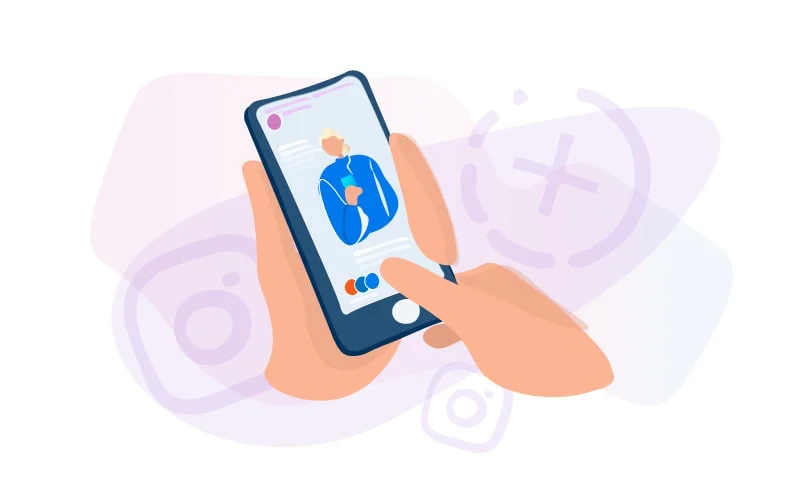Instagram Stories began with 15-second photos and videos. At first, they were perceived as an optional addition to the main feed. However, new Stories formats suddenly appeared some time ago.
Instagrammers began to make Stories longer. As a result, the followers started watching them to the end and paying more attention to them.
So, nowadays, the goal is to make Stories as engaging and interactive as possible. The concept of storytelling perfectly suits this objective and is widely used. Storytelling is a classic format. It used to belong to writers, screenwriters, and now it complements Instagram Stories.
Why posting series of Stories?
- Properly lined up Stories create a feeling that a person is watching a movie. This is a new narrative format — image plus text or video insertion. The content changes all the time, but the key message of the video runs like a golden thread. It’s effective in terms of perception.
- This is how the Instagram algorithm works: one of the essential indicators taken into account is retention. If a follower watches more Stories, the Stories have a higher reach. For Instagram, it’s a signal of quality, and it starts showing them to more users. It is also a way to increase the reach of your Stories significantly.
What is Storytelling?
In this case, Storytelling means using the elements of story-creation in your Stories and tools to keep attention — they are traditionally used by screenwriters and writers.

Storytelling techniques on Instagram
Slippery Slide
“Slippery slide” is a technique that makes the reader “fall” into your text. This principle was formulated by a famous copywriter Joe Sugarman; it states as follows: “The purpose of the first sentence in an ad is to get you to read the second sentence. The sole purpose of the second sentence is to get you to read the third sentence… and so on.” If this is applied to Stories, you have to line them up in such a way that each Story gives an incentive to go on reading, especially when it comes to the first two Stories.
Slippery Slide Formats
- A powerful promise you make from the very beginning, for instance: “Give me three minutes, and I’ll teach you to make cool Stories.” You’ve already captured the attention, the person is likely to go further, he/she already has a clear incentive and a reason to watch more Stories. Of course, this powerful promise must be kept.
- Unexpected fact. For example: “2021 will be the best year in SMM history.” To some extent, this is both a promise and an unexpected fact, which is further explained.
- Intrigue. It’s when you give a catching phrase in the first Story, an appeal that intrigues the user to read on.
- Question to the audience, to the reader. For example: “How often have you heard the word ‘Instagram’ over the past month?” And here, too, there is an interesting approach: to ask a question and anticipate the answer. In the second Story, you can write: “I bet you do, almost every day. So, now let’s talk about how to develop yourself on Instagram.” This is a perfect “slippery slide”: you managed to catch the attention of the user, developed his/her interest, explained what will happen next, and gave the reason to stay with you.
- Reading thoughts: you immediately anticipate the thoughts of a person in the first Story. For example: “I’m ready to bet that you would like to manage more in the same time.” Such an intake can be used for further analysis of time management techniques.
Rollercoaster
“Rollercoaster” is about take-off — fall, take-off — fall, negative-positive, negative-positive alternating in your Stories. For example, you share your experience and tell that “You’ve got a customer of your dreams” — this is a take-off, “but you faced a very serious problem in the car that he asked you to tune: you don’t offer the service he wants” — this is a fall, “the manager offered a solution” — this is a take-off, “but an hour before the delivery it turned out that…” — this is a fall. If you just say: “There was a client, we did a great job, everything was perfect, and everyone was satisfied” – it makes no sense for a person to watch 15 Stories because everything is just fine. So, you have to line up this “rollercoaster”.
Cliffhanger
This is yet another interesting storytelling tool perfectly matching the Stories format.
What is a cliffhanger? A classic example is when an episode in a series ends unexpectedly, and we have to wait for one more week to see what happens next. You can line up your Stories the same way.
‘Return with the elixir’
Another important element suggested by classical storytelling is the so-called ‘return with the elixir’. What does that mean? In the “hero’s journey” concept proposed by Campbell and then refined by Christopher Vogler, any story is divided into several stages, forming the hero’s metaphorical journey concluded with a ‘return with the elixir’ scene. Let’s imagine that you are talking about your case: “There was a client, we faced a problem, but then it turned out that… and the manager said… but an hour before the delivery the lights went off…” and so on. If you simply say: “We returned the car” and put a full stop, it creates a feeling that something is missing; you need an epimyth.
Indeed, in storytelling, it works better if you sum it up. The reader or viewer went through a journey by your side, faced challenges, overcame them together with you. In conclusion, you have to return with the elixir: “From this situation we have learned the following: from now on, when agreeing with the client, we will set this and that from the very beginning.”
Principles of Storytelling in Stories
- Narrative layer presence. You can add the text to the Story or articulate it.
- Diverse visual content. Try to select images, photos, videos, and GIFs that correspond to what is written. Moreover, it is vital to create different types of content always. First, you use a photo, then choose a caricature, after that — a short video, and so on. The picture should change; this creates motion and allows you to hold attention.
- Essentials. If you are talking, add a written text to your Story. Unfortunately, this is often neglected. Add only key information.
- Don’t forget to keep your content interactive. Stories are amazing because they provide two-way communication. You tell and show, but at the same time, the audience has the opportunity to contact you: the users can answer questions, participate in surveys, take part in tests, etc.
There are many different approaches to Stories. You can create Stories the old way, or you can follow the storytelling concepts. The statistics show that in the second case, the reach, engagement rate, and loyalty of the audience increase significantly.





